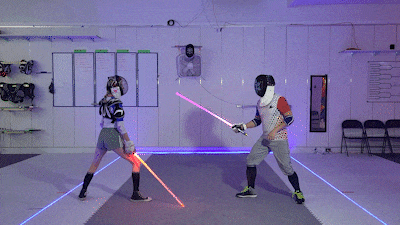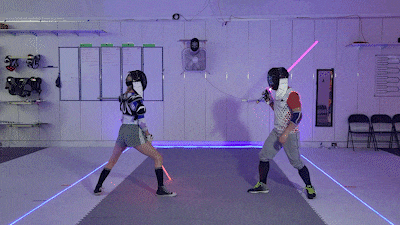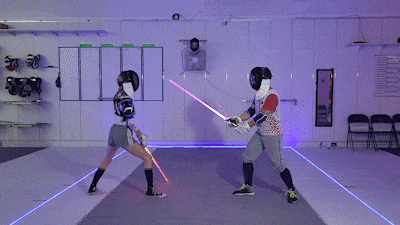Use the information here to spot and correct reckless fencing in yourself and your teammates.
WHAT IS EXCESSIVE FORCE/POWER?
Excessive force is the inaccurate targeting of attack acceleration. Excessive attacks might:
Accelerate through a target rather than to a target, or
Aim for the entire person rather than a particular target on that person, or
Contact multiple targets on that person
The circle represents the approximate area to which an attack should accelerate (for this particular target and angle). Anywhere below the circle, while motion may continue, acceleration should halt, for example, by using percussing or tucking.
The attacks on the right go far past the mass of the glove, so much so that, were they to make contact, they would easily contact both the glove and the knee (multiple targets).
While attacks on both sides of the video move through the target, only attacks on the right accelerate through the target.
USE THE FORCE(SIGN)
Only the fencer being struck truly knows how hard they were hit. As an outside observer, you may be tempted to use sound or speed as a measure, but neither of these can be evaluated accurately by a human being, let alone many. In Lightspeed, you will instead use Force Sign.
Force Sign refers to a family of visual indicators that allow an observer to detect excessive force. Visual evidence can be seen and confirmed by everyone, and even evaluated via video replay. Most importantly, you can explain visual indicators to the violating fencer, who can then correct their behavior.
FORCE SIGN #1: rigid arms
If there is a rigid or locked out arm, and the attack is moving at competitive speed, there’s a good chance the attack is excessive. While it’s possible to deliver a controlled attack with rigid arms, it is difficult to deliver an excessive strike without them.
The worst hits in Lightspeed were performed with rigid, locked out arms. Note that rigid arms can be used to spot force in attacks that hit as well as attacks that miss.
FORCE SIGN #2: OVERSHOOTS
These are attacks that miss their target and clearly go beyond where the target’s surface would have been, indicating that the force was excessive.
Blade Sign
It is easy to tell when a blade has been accelerated beyond necessity when the attack misses. When an at attack lands, however, this can be more difficult because there is a physical body preventing passage of the blade. In this case, we rely on a subclass of Force Sign called Blade Sign. Blade Sign manifests exclusively during a hit, most often when excessive force is applied.
Bending. The blade bends into the opponent (as opposed to away— common to perfectly safe percussive cuts).
Skipping. This blade bends and bounces off the opponent while still moving through its original path.
Chain contact. Attack hits or drags across multiple targets on the opponent.
Attack glances off or presses into target
Attack bounces or strikes multiple times
WHAT IS REASONABLE FORCE?
Reasonable force is the accurate acceleration of an attack to a target’s surface, for example, your aim is to strike:
The skin of your opponent’s shoulder, not the muscle and bone underneath
Your opponent’s glove, not the hand inside
Your opponent’s mask, not their head
Your opponent’s elbow guard, not their elbow, etc.
A reasonable or fair attack:
Accelerates to a target rather than through a target
Aims for a particular target— like the mask or glove or shoulder— on a person, not the whole person.
Contacts just one target, once, without any bouncing, skipping, bending, or any other Force Sign.
If it would move through a target or multiple targets, then it does so with a tuck.
reasonable FORCE IS NOT:
Attacking slowly / noncompetitively / incompetently— this is a competitive sport; speed and skill are requirements for success.
Never causing pain— some fencers are more sensitive than others; some competitors are floppers; some incidents are unforeseeable; pain is not an indictment by itself.
Never causing bruises— some fencers bruise easily; bruises are not an indictment by themselves.
Never making a loud sound when making contact— the fencing mask, the saber hilt, and certain types of armor or padding make a loud noise when struck; sound is not an indictment by itself.
This Long Percussive counterattack exhibits no Force Signs, and therefore would generally be considered a fair hit. The receiving fencer would be advised to purchase a padded jacket.






